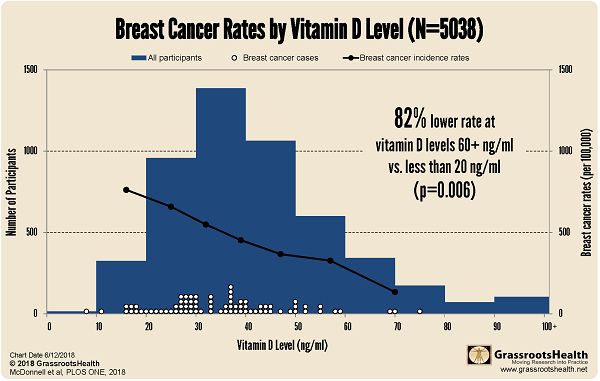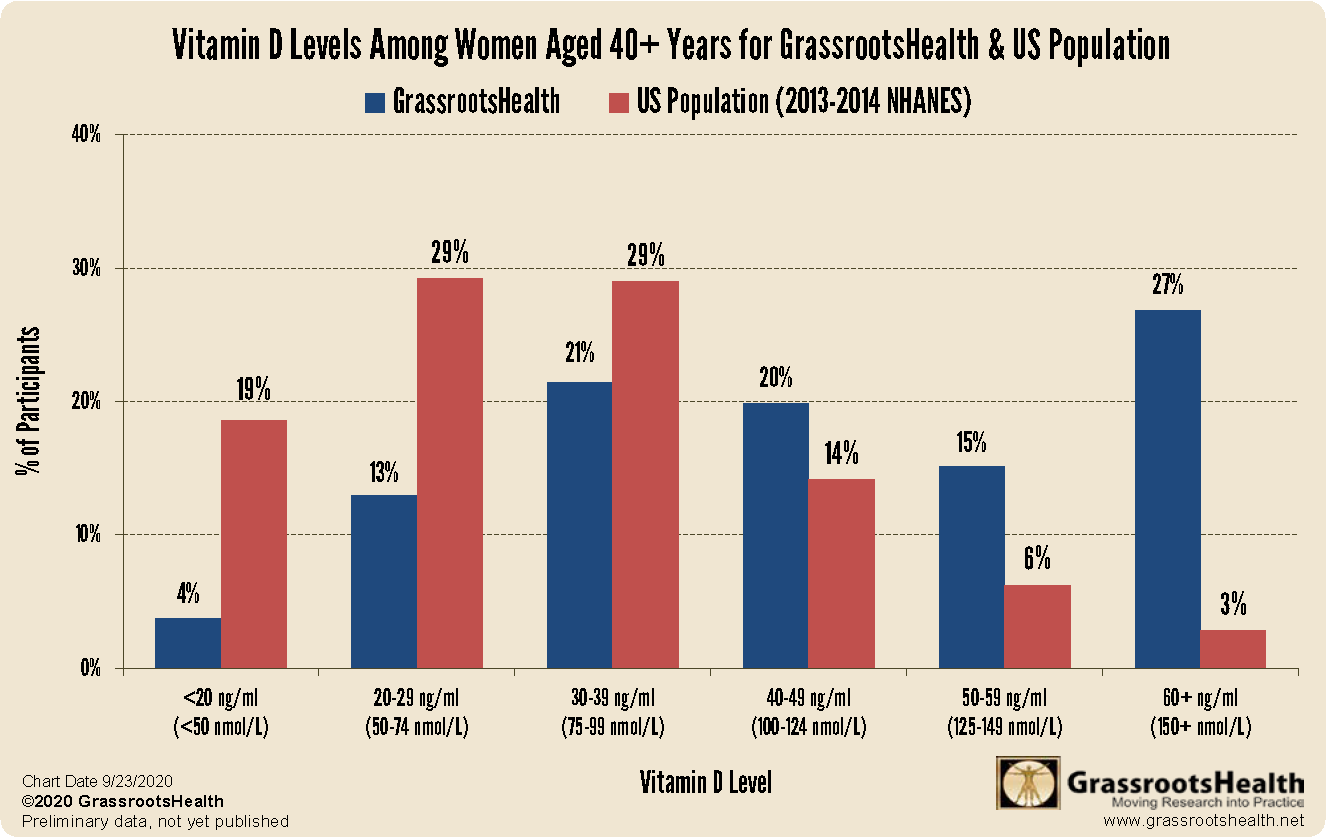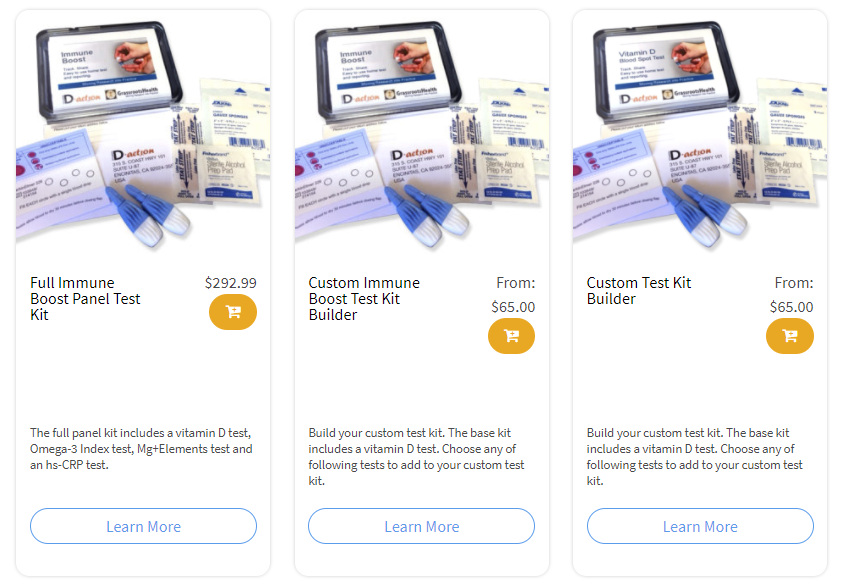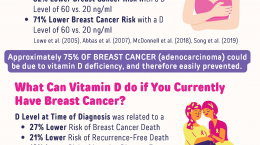Published on October 1, 2020
 Each October, when the world focuses on awareness for a cure for breast cancer, GrassrootsHealth reminds everyone that prevention deserves just as much or even more attention. If up to 80% of all current breast cancer cases could have been prevented or avoided, saving each of those women from the experience of even getting breast cancer in the first place, wouldn’t it be better than having to find a cure for those 80%?
Each October, when the world focuses on awareness for a cure for breast cancer, GrassrootsHealth reminds everyone that prevention deserves just as much or even more attention. If up to 80% of all current breast cancer cases could have been prevented or avoided, saving each of those women from the experience of even getting breast cancer in the first place, wouldn’t it be better than having to find a cure for those 80%?
We want to thank all of you who have participated in the breast cancer prevention project thus far. You are helping re-shape the discussion and change the world!
How could 80% of breast cancer cases possibly be prevented?
A recent study pooled and analyzed data from two randomized controlled trials, led by Dr. Joan Lappe at Creighton University (2007, N=1129 and 2016, N=2196), and data from the GrassrootsHealth Breast Cancer Prevention Study cohort (N=1713). This analysis aimed to investigate the relationship between vitamin D level and breast cancer risk across a broad range of vitamin D concentrations among women aged 55 years or older. Within the pooled cohort (N=5038), 77 women were diagnosed with breast cancer during the observation periods (median follow-up time: 4.0 years) with an age-adjusted incidence of 512 cases per 100,000 person-years. Comparing incidence rates of breast cancer by vitamin D level showed an 82% lower rate for women with 25(OH)D concentrations of at least 60 ng/ml compared to less than 20 ng/ml (P = 0.006).
As you can see on the chart above, vitamin D levels have a significant correlation with breast cancer incidence. The horizontal axis shows increasing vitamin D levels, from 0 to 100 ng/ml. The vertical axis on the left-hand side shows the number of people in the blue bars that fall into each 10-ng/mL block of vitamin D levels. The breast cancer cases are shown by the white dots, with each dot representing a single case.
It is worth noting that most of the dots (69%) are below 40 ng/ml (100 nmol/L), and very rarely above 60 ng/ml (150 nmol/L). The vertical-axis on the right is for the incidence rate of breast cancer which is shown on the chart by the black dots and connecting line.
The GrassrootsHealth Effort to Help Prevent Breast Cancer
The first health-focused project initiated by GrassrootsHealth soon after its founding was the Breast Cancer Prevention study, which enrolled women over the age of 60 who were currently cancer-free, to track their vitamin D levels regularly along with their health outcomes and cancer incidence. The paper featured above was made possible thanks to the women in that study who contributed their time and information!
Now, the Breast Cancer Prevention project is open to all women, since the risk for breast cancer could potentially be reduced when taking action at any age! With many medical groups recommending breast cancer screenings starting at age 40, why not also ensure vitamin D levels are within the target range for reducing breast cancer risk by that age as well?
GrassrootsHealth took a quick look at the 2013-2014 NHANES data for vitamin D levels among US women, ages 40 and above, and compared it to vitamin D levels of the same age women within the GrassrootsHealth cohort.
As you can see from the chart above, with a target vitamin D level of at least 60 ng/ml (as that was the level showing the 80% reduced risk in breast cancer above), 97% of women in the general US population were below that level, compared to 73% of the women in the GrassrootsHealth cohort.
Do you know your vitamin D level? Take action now to reach your target vitamin D level; start by finding out what your level is today.
Many other studies have also been published showing a decreased risk of breast cancer associated with a higher vitamin D level! A summary of this research can be found on our Breast Cancer Prevention Study project page.
Stay tuned over the rest of the month of October for more information on vitamin D and other nutrients that may help reduce the risk of breast cancer.
Are Nutrient Deficiencies Hindering Your Immune System?
Could getting more of certain nutrients help to decrease your levels of inflammation and improve your immune response? Find out by testing your vitamin D, omega-3s, magnesium and other essential elements (including copper and zinc), as well as your inflammation levels, with the new Immune Boost home test kit offered by GrassrootsHealth. Measuring levels is the only way to know if you are supporting your immune system and whether additional changes should be made, with supplementation, dietary changes, or both.
Enroll now with the Full Immune Boost Panel (which includes tests for vitamin D, Omega-3 Index, magnesium, zinc, selenium, copper, and hsCRP), and get 10% off when you use coupon code BoostTen at checkout.
What Does it Take YOU to Get Your D to 40 ng/ml (100 nmol/L)?
Did you know your health could be greatly affected by making sure you have a vitamin D level of at least 40 ng/ml (100 nmol/L)? Help us help you.
STEP 1 – Do you know what your vitamin D level is? If not, be sure to test today to find out.
STEP 2 – Determine your target level. Are you at your target level? Experts recommend a level of at least 40-60 ng/ml (100-150 nmol/L).
STEP 3 – Need to boost your level? Use the D*calculator to see how much vitamin D it may take to reach your target. Opt for the Loading Dose for a quicker boost.
STEP 4 – Optimize how your body absorbs and utilizes vitamin D with co-nutrients and these simple steps.
STEP 5 – Re-Test! This is an important step to make sure you have reached your target level, and to ensure you are not taking too much! Re-testing after 3-4 months is recommended.
STEP 6 – Adjust, Repeat…
Give your immune system the nutrients it needs to support a healthy you and protect yourself from unnecessary diseases, especially COVID-19.
NEWS ALERT
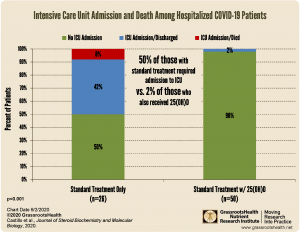 The first Randomized Controlled Trial on vitamin D and COVID-19 has shown a 96% lower risk of ICU admission for those receiving vitamin D (as 25(OH)D to quickly boost vitamin D blood levels) along with the standard treatment, compared to those receiving standard treatment alone.
The first Randomized Controlled Trial on vitamin D and COVID-19 has shown a 96% lower risk of ICU admission for those receiving vitamin D (as 25(OH)D to quickly boost vitamin D blood levels) along with the standard treatment, compared to those receiving standard treatment alone.
These results support many previous observational studies showing a relationship between vitamin D levels and intake and COVID-19 severity.
Review the Latest Nutrient Research for COVID-19
GrassrootsHealth Nutrient Research Institute has launched the new Immune Boost project with the use of our myData-myAnswers nutrient health system that nearly 15,000 people are already using for their health. Specific markers that influence immune health are suggested for testing as part of this project including:
- Vitamin D
- Omega-3 Index
- Essential elements magnesium, selenium, and zinc
- hsCRP
Our goal is to demonstrate how one can use the Nutrient Research Model established by Dr. Robert Heaney to show the effect of vitamin D serum levels of at least 40 ng/ml (100 nmol/L) on risk reduction for all ethnicities in the population. Status and intake of other nutrients will also be analyzed for any type of relationship to immune status and symptom severity. Join the project today!
Please let us know if you’re interested in helping sponsor this project.
Through GrassrootsHealth Nutrient Research Institute, you can also test your essential elements magnesium, copper, zinc and selenium, toxins such as lead, mercury and cadmium, as well as your omega-3 levels, inflammation levels and thyroid stimulating hormone (TSH) level. Find out your levels today! Log on to the test selection page (click the link below) to get your tests and see for yourself if your levels can be improved.
Make sure you track your results before and after, about every 6 months!
Click Here to Access the Test Page
How can I track my nutrient intake and levels over time?
To help you track your supplement use and nutrient levels, GrassrootsHealth has created the Personal Health Nutrient Decision System called
For each specific supplement, you can track what days you take it, how much, and many other details. This will help you know your true supplemental intake and what patterns of use work for you to reach and maintain optimum nutrient levels. Check it out today!


